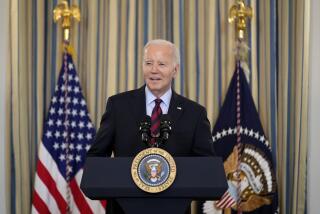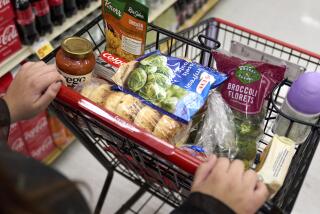The grim economics of food stamps
- Share via
The day after Halloween, the federal government rolled back food stamp benefits for all 47.6 million people who receive them, officially ending one of the last remaining stimulus efforts left over from President Obama’s first months in office — while also making it harder for millions of Americans to get enough to eat. The callousness displayed in cutting vital safety net benefits at a time when millions lack the resources to feed their families adequately has been much discussed. What has gotten less attention is that the cut in food stamps is not good economic policy either.
The 5.5% reduction in benefits will pull about $5 billion in federal spending out of the economy over the coming 10 months — $457 million in California alone. Those were borrowed dollars, so the savings bring Washington one small step closer to fiscal sustainability. Yet the federal government won’t make it all the way there without faster economic growth, and putting less food on poor Americans’ tables won’t help.
Congress increased the maximum food stamp benefit by 13.6% in April 2009 as part of the American Recovery and Reinvestment Act, a $787-billion effort to stimulate the economy. It wasn’t a temporary increase; instead, it was meant to pay in advance the cost-of-living adjustments that the program was expected to receive over the subsequent five years. And because food stamp benefits are spent quickly, not saved, the increase was expected to help stimulate the moribund economy. By one estimate, every $1 in food stamps leads to $1.70 in economic activity.
But lawmakers soon siphoned off some of the budget for higher food stamp benefits, using it to help pay for Medicaid benefits, teacher salaries and a childhood nutrition program. As a result, rather than keeping food stamp benefits at the higher level until inflation caught up, the benefits were cut across the board Nov. 1. For a family of four, the maximum monthly benefit will shrink by $36, to $632. For the average recipient, the aid will drop to $1.40 per meal.
Even with the lowered benefits, the price tag for food stamps — formally known as the Supplemental Nutrition Assistance Program — is enormous, costing close to $80 billion a year. That’s because the deep recession caused food stamp rolls to expand rapidly, and stubbornly high unemployment has kept the number of recipients from dropping. The new farm bill that lawmakers are negotiating will almost certainly shrink that number because both chambers want to make fewer people eligible for the benefits.
The percentage of the population on food stamps is alarming, but lawmakers shouldn’t mistake a symptom of the economy’s problems for its cause. They also have to recognize, as they try to navigate their way out of massive, recession-fueled deficits, that pulling federal dollars out of the economy has consequences too. It’s a balancing act. The best way to cut spending on food stamps isn’t to lower benefits or make them harder to obtain, it’s to speed up economic growth and put jobless Americans back to work. That also happens to be the most effective way to reduce the deficit.
More to Read
A cure for the common opinion
Get thought-provoking perspectives with our weekly newsletter.
You may occasionally receive promotional content from the Los Angeles Times.










